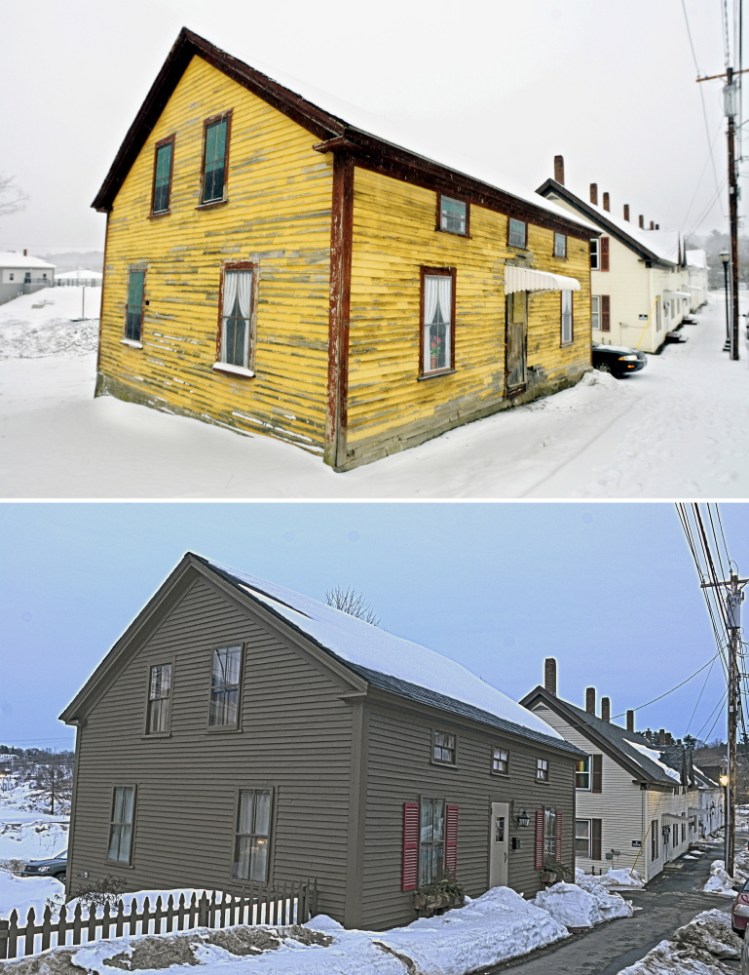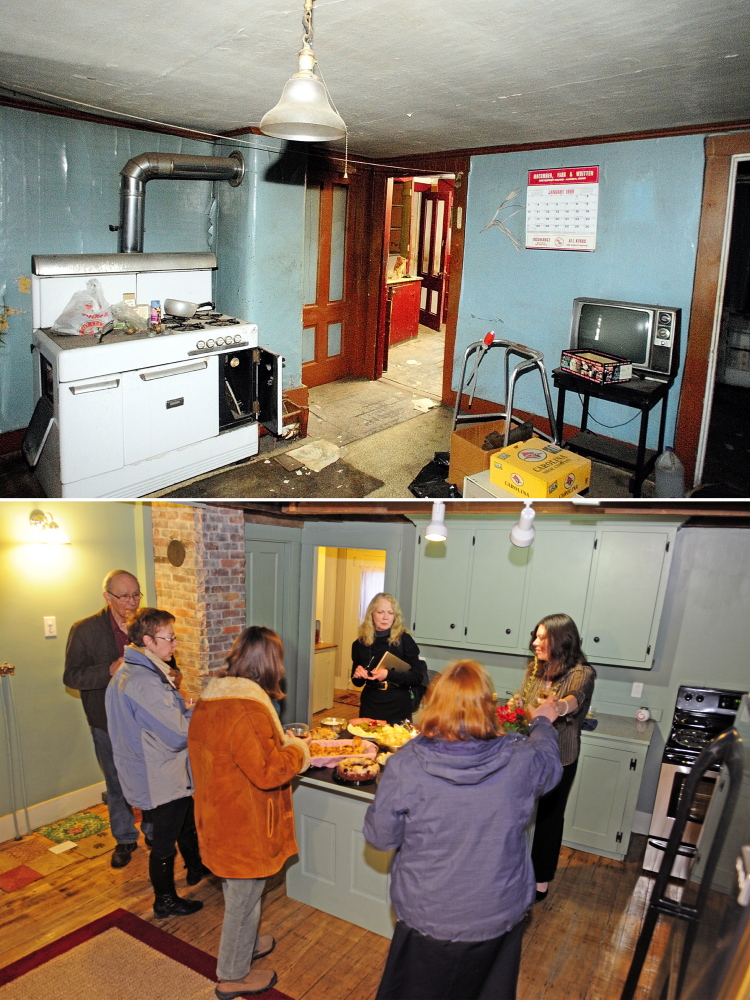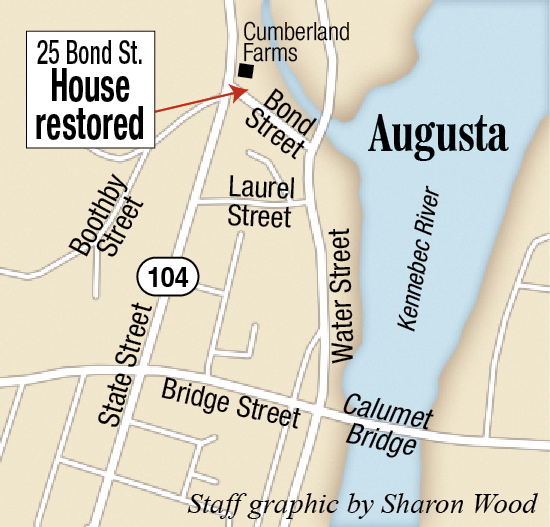AUGUSTA — Its wooden floors may be worn by a century of the shuffling of mill-workers’ boots and crooked from recent years of neglect, but 25 Bond St. has avoided demolition to become a historic and restored landmark.
Historic preservation advocates say it represents a rare victory for historic preservation in Augusta.
Local landlord Larry Fleury bought the modest-sized row house on the corner of Bond Street and Mt. Vernon Avenue from the city in 2013 for a nominal $1. He taped a nickel to his offer to the city, a light-hearted way to provide the 5 percent deposit required in the city’s request for proposals to buy and preserve the historic but then-dilapidated building. He was the only bidder, which wasn’t surprising given the property’s rough condition, officials said at the time.
Last week, after six months of renovations by his workers from River City Realty, Fleury unveiled the restored home to rave reviews by historic building fans, who said he had saved one of only a few remaining examples of mill-worker housing from the time period when the nearby former Edwards Manufacturing mill dominated the local economy.
The home wasn’t, and isn’t, very large nor overly fancy. And it was built, sometime around 1870, using wood and other building materials salvaged from other buildings, possibly including an 1820s shed that Fleury said may have been used as the starting point for the home.
“Some people say it reminds us of the difficult past here, and why would you want to remember that?” said Phyllis von Herrlich, a historian and member of the Augusta Historic Preservation Commission and board member of Kennebec Historical Society. “But if you look at this building, it epitomizes the strength and hard work of the people who lived here. I’m so happy Larry stepped forward and said, ‘I’ll take this house on.'”
Earle Shettleworth Jr., state historian and director of the Maine Historic Preservation Commission, congratulated Fleury, who owns other apartment buildings on the short Bond Street and also has his own home nearby at the intersection of Bond and Water streets, for the “wonderful” restoration of the three-bedroom home.
It is a building that some, including the former owner of an apartment building in the neighborhood, said was so far gone it should have been torn down. The city bought the building in 2000 for $14,500 from St. Mary of the Assumption Catholic Church, which had been willed the home at the death of its previous owner, John Dienaltoski.
A 2004 study committee concluded it would cost too much for the city to restore the building, or, as some had hoped, to turn it into a museum. A neighbor asked the city to demolish it, but instead the city sold it to Fleury with requirements that it be preserved.
“I’ve been here 17 years, and this house has occupied some of my attention for most of those 17 years,” said City Manager William Bridgeo. “It seemed like there was always one reason or another to tear it down. But there was so much passion in the community to save it, it became infectious. In the end (Fleury) came through and did a great job. It’s a historic preservation success story.”
Fleury said he bought the building to restore it and help make the whole neighborhood more attractive. He plans to rent it out at $850 a month. He said he had one tenant lined up but that deal fell through, so while he’s received interest in renting it out, it is available.
He and his workers put a lot of effort into preserving as much of the existing structure as they could, repairing plaster instead of putting up much new Sheetrock, ripping out ceilings to expose its wooden beams, and sanding down the original wood floors.
Fleury acknowledges the home’s floors are still crooked, and more than one attendee of the open house last week joked that they felt a bit drunk while walking around the home. Fleury said they spent a month-and-a-half jacking the building up, trying to level it out, going underneath it every day of that time period to jack it up an inch at a time. But he said they reached the limit of how much it could be jacked up without causing other damage.
The kitchen features an island made out of wood salvaged from other parts of the home, and original retained features include wood trim and siding.
“I know this was an important house to the community, and I appreciate you folks giving me a chance to do something with it,” Fleury told officials at the open house. “I’m thrilled with how it came out. It was a major undertaking that took a lot of time away from a crew that, frankly, should have been out shoveling.”
Fleury wore a button, given to him by von Herrlich, that said “Save 25 Bond St.,” joking he’d modify his to say “Saved 25 Bond St.”
In 2001 the entire Bond Street neighborhood was declared by Maine Preservation to be one of Maine’s most endangered historic properties. Von Herrlich said the “Save 25 Bond St.” buttons dated to local efforts begun in 2001 to prevent the historic home, which is now on the National Register of Historic Places, from being demolished.
“It has been a really long, long, long haul,” she said.
Fleury gave a series of unique murals painted on boards used to cover the windows of the home when the city owned it to artist Jane Burke, who coordinated volunteer efforts to paint them. The murals depicted windows, some with people peering out of them. They were so realistic Bridgeo said a neighbor, a few years ago, called to ask the city to remove the one that faced the neighbor’s apartment building, because the male figure in the painting looking out at them creeped them out.
Delaine Nye, who was on the city council and chairwoman of a committee formed to determine what to do with the building in the early 2000s, said with the economy struggling at the time, they decided the best thing they could do was “mothball” the home.
“What a change,” she said while touring the restored building. “I think he has done a great job with it.”
The home, previously painted on the outside in a distinctive, mustard-like color, is now a dark brown outside with a mostly green and “antique rose” painted interior, colors Fleury said were chosen from the National Trust for Historic Preservation palette of recommendations.
Keith Edwards — 621-5647
kedwards@centralmaine.com
Twitter: @kedwardskj
Send questions/comments to the editors.






Success. Please wait for the page to reload. If the page does not reload within 5 seconds, please refresh the page.
Enter your email and password to access comments.
Hi, to comment on stories you must . This profile is in addition to your subscription and website login.
Already have a commenting profile? .
Invalid username/password.
Please check your email to confirm and complete your registration.
Only subscribers are eligible to post comments. Please subscribe or login first for digital access. Here’s why.
Use the form below to reset your password. When you've submitted your account email, we will send an email with a reset code.